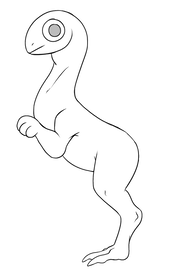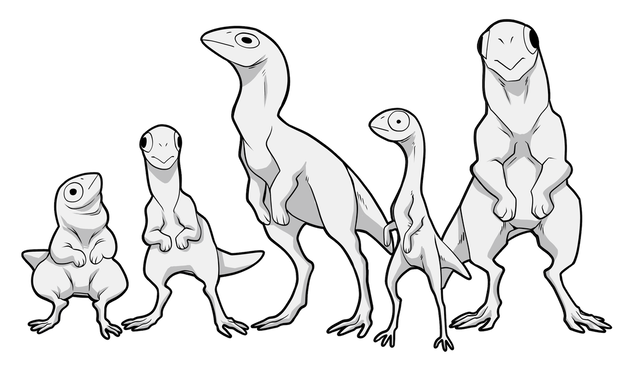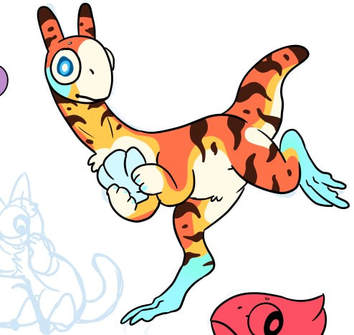Species
Chup-Chup
Visual Trait IndexSummary

Soul Essence Location: Eyes, Feet, nails, mouth, blood and innards.
Bone/Teeth/Nail colour: White, or off-white.
Required Traits: Feelers, Eyes, Tails, Texture
Average Height:
2 ft 3 iches - 3 ft 8 inches
Diet: Omnivorous. Chup-Chups are opportunistic feeders, consuming a variety of insects, seafood, and plants. Their skittish nature makes them quick eaters, preferring to snatch food items on the go.
Location: Coastal regions, jungles, forests, and surprisingly, even tundras. These adaptable creatures thrive in diverse environments, seeking refuge in abundant hiding spots to avoid predators.
✦ General Info ✦
General Info

(Chuu-p Chuu-p)
Chup-Chups are peculiar, bipedal creatures covered in feathers, native to the coastal and jungle regions of the Juju Islands. Known for their rapid, skittering movements, they exude a constant air of nervousness.
Their distinctive wall-eyes grant them a unique 360-degree vision, similar to a chameleon.
Historically, Chup-Chups were a prized delicacy for the Impishun and Haiwari people, as their widespread population made them a readily available food source. Beyond sustenance, certain Chup-Chups were cherished as pets and traded between villages.
Legend has it that the Goddess Hikissu crafted these creatures from leftover ash, mud, and leaves of the primordial jungles. She sought the God D'Jhakol's expertise to breathe life into her creation, finally persuading him to do so with a touch of divine energy. Their current form is the result of this collaborative effort.
Exceptionally beautiful and talented Chup-Chups, renowned for their singing abilities, commanded high prices and were often depicted on the temples of the wealthy. Less desirable specimens, unfortunately, met a different fate.
Many tribesmen incorporated Chup-Chup feathers, fur, leather, eye cusps, and bones into their adornments or musical instruments, such as the popular Midga pan-flute.
However, the declining hunting of Chup-Chups has led to a population surge, transforming them into pests as they encroach upon human settlements. Their disruptive behaviors include rummaging through garbage, destroying gardens, and seeking sustenance in gutters, driven by habitat loss.
Larger, stronger Chup-Chups have found a new purpose in the world of entertainment. These agile creatures are the stars of thrilling races, becoming a popular spectator sport and a lucrative betting opportunity, rivaling the prestigious Draquine Derby.
✦ Anatomy ✦
Anatomy

Chup-Chups possess unique physical characteristics that reflect their lifestyle and diet. Their feet resemble those of birds, with textures ranging from leathery smooth to scaly. Interestingly, pampered or pet Chup-Chups tend to have smoother and sleeker legs, perhaps due to a less demanding environment.
Dominating their facial features are large, bulging eyes similar to a chameleon's. These eyes, despite their intimidating size, boast a soft inner tissue protected by a hard outer layer reminiscent of goggles. This structure is essential for their characteristic "wall-eyed" appearance. However, rough fights or injuries can damage this eye casing. Additionally, these remarkable eyes can move independently from one another, offering a wider field of vision.
Chup-Chups are typically small in size, roughly the height of a chicken. Their mouths, while fleshy, possess beak-like qualities that enable them to break into hard materials like nuts, rocks, and shells. Notably, they lack significant teeth, although some depictions showcase back molars.
Their small, soft paws have 3-4 fingers each and lack both retractable claws and pawpads. Vocalizations are a far cry from melodious, a mixture of purrs, seagull screeching, and crow caws. Beautifully singing Chup-Chups are a rare occurrence in the wild.
These creatures are surprisingly athletic, capable of running in short bursts at speeds of 50-70 miles per hour. Their agility extends to swimming against strong currents. In the past, islanders would even chase them for sport.
Additionally, they come in a wide variety of shapes and sizes, from thin and muscular to chubby. As long as their height stays within the species' average, feel free to design a Chup-Chup that suits your artistic vision!
✦ Head Shapes ✦
Head shapes

Chup-Chup heads combine features of both birds and fish. They typically have smooth craniums without many bumps or dents. While some variation is allowed for the eyes, they should maintain a fish-like appearance.
✦ Behaviour ✦
Behaviour

Chup-Chups are social creatures, with a strong need for companionship. While wild Chup-Chups rarely interact with other species, they thrive in large groups of their own kind. These groups huddle together for warmth and act as a unit when scavenging for food. This behavior suggests a potential defense mechanism against predators.
Despite their sociable nature, Chup-Chups are messy eaters, known for swallowing their food whole in a single gulp (or at least attempting to). Interestingly, they seem to tolerate the presence of Quakou, a different island creature. Some speculate this may even be a symbiotic relationship, with both species alerting each other of danger.
Chup-Chups can be quite vocal, expressing their emotions loudly with screeches when they feel distressed, upset, injured, or simply hungry. This trait can be reminiscent of a young child's tantrums.
While easily distracted, Chup-Chups are surprisingly trainable, capable of learning new tricks with plenty of patience. Territorial battles are rare due to their skittish nature, but when they do occur, Chup-Chups use their strong back legs to jump and claw at opponents. These scuffles typically last mere seconds before one side is spooked and retreats.
The parental instincts of Chup-Chups are quite strong. They act as a family unit, taking turns caring for and protecting their eggs and young. Chup-Chup groups have even been known to work together to drive away lone predators who get too close to their offspring.
✦ Life Cycle ✦
Life cycle


Birth:
---
Death:
---
